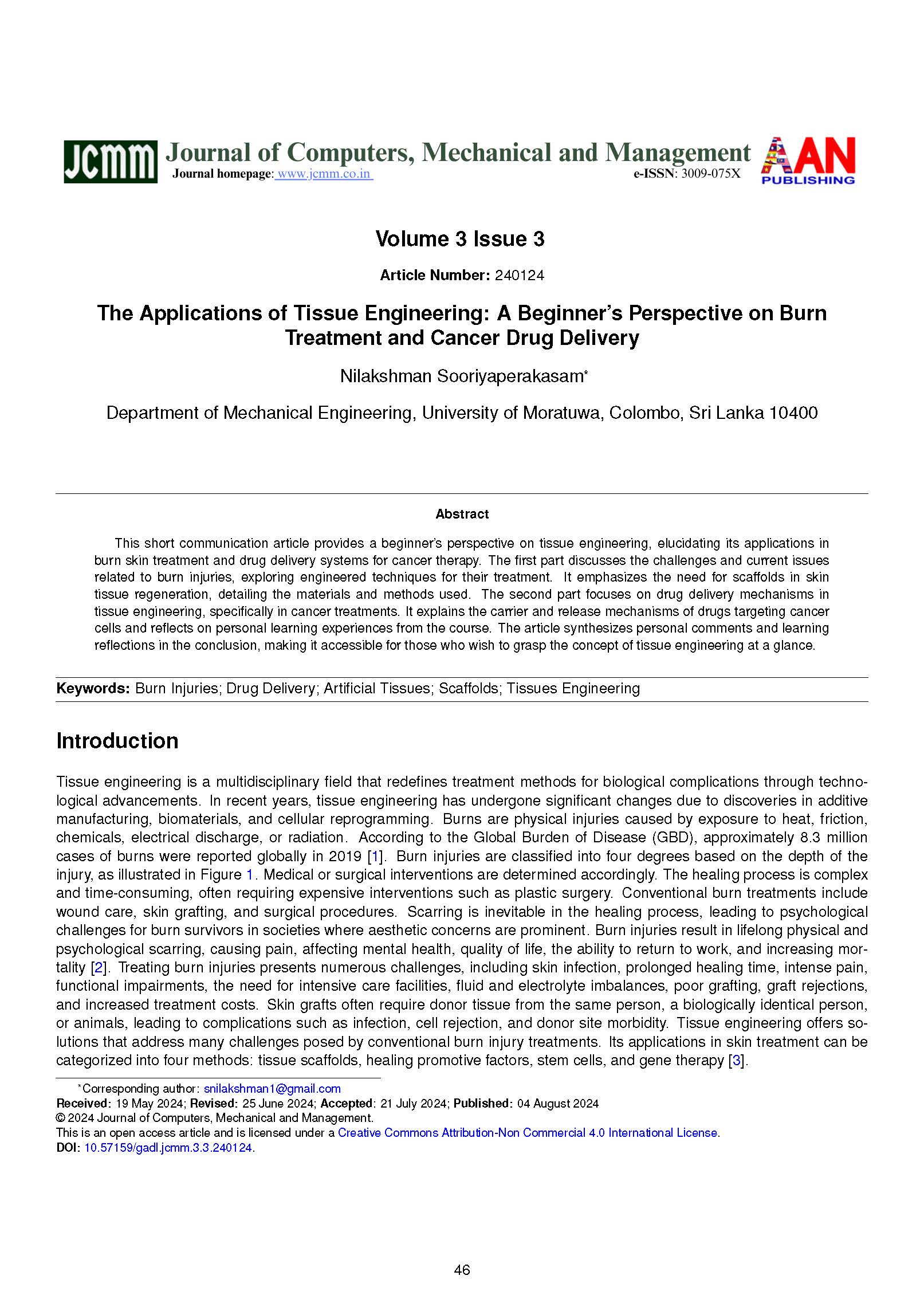The Applications of Tissue Engineering
A Beginner's Perspective on Burn Treatment and Cancer Drug Delivery
DOI:
https://doi.org/10.57159/gadl.jcmm.3.3.240124Keywords:
Tissue Engineering Applications, Burn Skin Treatment, Cancer Drug Delivery, Scaffold Regeneration, Biomedical EngineeringAbstract
This article is written from a beginner's perspective to elucidate the concept of tissue engineering through its applications. It elaborates on the role of tissue engineering in burn skin treatment and drug delivery systems for cancer therapy. The first part of this article discusses the challenges and current issues related to burn injuries and the engineered techniques for their treatment. It highlights the need for scaffolds in skin tissue regeneration, along with the materials and methods used for treatment. The second part focuses on drug delivery mechanisms in tissue engineering, specifically in cancer treatments, explaining the carrier and release mechanisms of drugs targeting cancer cells. Most information was gathered from scientific articles, following the selection of focused applications. The basics of these applications were studied and explained in layman's terms, forming the foundation for an application-based learning experience. Personal reflections and comments are synthesized in the conclusion, making it accessible for those who want to learn about tissue engineering at a glance.
References
A. Yakupu, J. Zhang, W. Dong, A. Abliz, L. Fang, H. Wang, and S. Ma, “The epidemiological characteristic and trends of burns globally,” BMC Public Health, vol. 22, p. 1596, 2022.
S. A. Mason, A. B. Nathens, J. P. Byrne, A. Gonzalez, R. A. Fowler, P. J. Karanicolas, and D. Gomez, “Increased rate of long-term mortality among burn survivors,” Annals of Surgery, vol. 269, no. 6, pp. 1192–1199, 2019.
A. Oryan, E. Alemzadeh, and A. Moshiri, “Burn wound healing: present concepts, treatment strategies and future directions,” Journal of Wound Care, vol. 26, no. 1, pp. 5–19, 2017.
N. K. Selvan, T. S. Shanmugarajan, and V. N. V. A. Uppuluri, “Hydrogel-based scaffolding polymeric biomaterials: approaches towards skin tissue regeneration,” Journal of Drug Delivery Science and Technology, vol. 55, p. 101456, 2020.
M. Hosseini and A. Shafiee, “Engineering bioactive scaffolds for skin regeneration,” Small, vol. 17, no. 29, p. 2101384, 2021.
S. Gurunathan, M.-H. Kang, M. Qasim, and J.-H. Kim, “Nanoparticle-mediated combination therapy: two-in-one approach for cancer,” International Journal of Molecular Sciences, vol. 19, no. 10, p. 3264, 2018.
M. S. Aslam, S. Naveed, A. Ahmed, Z. Abbas, I. Gull, and M. A. Athar, “Side effects of chemotherapy in cancer patients and evaluation of patients’ opinion about starvation-based differential chemotherapy,” Journal of Cancer Therapy, vol. 5, pp. 817–822, 2014.
M. Chamundeeswari, J. Jeslin, and M. L. Verma, “Nanocarriers for drug delivery applications,” Environmental Chemistry Letters, vol. 16, no. 1, pp. 50–65, 2018.
F. M. Kashkooli, M. Soltani, and M. Souri, “Controlled anti-cancer drug release through advanced nano-drug delivery systems: static and dynamic targeting strategies,” Journal of Controlled Release, vol. 327, pp. 316–349, 2020.

Downloads
Published
How to Cite
Issue
Section
License
Copyright (c) 2024 Journal of Computers, Mechanical and Management

This work is licensed under a Creative Commons Attribution-NonCommercial 4.0 International License.
The Journal of Computers, Mechanical and Management applies the CC Attribution- Non-Commercial 4.0 International License to its published articles. While retaining copyright ownership of the content, the journal permits activities such as downloading, reusing, reprinting, modifying, distributing, and copying of the articles, as long as the original authors and source are appropriately cited. Proper attribution is ensured by citing the original publication.





